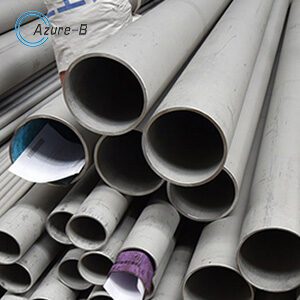Description
EN 10216-5 Stainless Steel Tube
EN 10216-5 Stainless Steel Tube

Stainless steel tube is a hollow, elongated, circular steel material widely used in industrial transportation pipelines and mechanical structural components such as petroleum, chemical, medical, food, light industry, mechanical instruments, etc. In addition, when the bending and torsional strength are the same, the weight is relatively light, so it is also widely used in the manufacturing of mechanical parts and engineering structures. It is also commonly used as furniture, kitchenware, etc.
hardness
Stainless steel tubes generally use Brinell, Rockwell, and Vickers hardness indicators to measure their hardness.
Brinell hardness hardness is the most widely used in stainless steel pipe standards. Brinell hardness hardness is often expressed by indentation diameter, which is intuitive and convenient. However, it is not suitable for steel pipes made of harder or thinner steel.
Vickers hardness
The Vickers hardness test for stainless steel tubes is also an indentation test method that can be used to measure the hardness of very thin metal materials and surface layers. It has the main advantages of the Brinell and Rockwell methods and overcomes their basic disadvantages, but it is not as simple as the Rockwell method, and the Vickers method is rarely used in steel pipe standards.
Hardness testing
Annealed stainless steel tubes with an inner diameter of over 6.0mm and a wall thickness of less than 13mm can be tested using a W-B75 Vickers hardness tester, which is very fast and simple, and is suitable for rapid non-destructive qualification inspection of stainless steel pipes. Stainless steel pipes with an inner diameter greater than 30mm and a wall thickness greater than 1.2mm are tested for HRB and HRC hardness using a Rockwell hardness tester. Stainless steel pipes with an inner diameter greater than 30mm and a wall thickness less than 1.2mm are tested for HRT or HRN hardness using a surface Rockwell hardness tester. Stainless steel pipes with an inner diameter less than 0mm and greater than 4.8mm are tested for HR15T hardness using a dedicated Rockwell hardness tester for pipes. When the inner diameter of a stainless steel pipe is greater than 26mm, a Rockwell or surface Rockwell hardness tester can also be used to test the hardness of the inner wall of the pipe.
Steel pipes can be referred to as steel pipes that have hollow sections with openings at both ends and a larger ratio of their length to the circumference of the section. When the ratio of length to cross-sectional circumference is small, it can be referred to as a pipe segment or pipe fitting, which belongs to the category of pipe products.
For over sixty years, architects have been using stainless steel to build cost-effective permanent buildings. Many existing buildings fully demonstrate the correctness of this choice. Some are very ornamental, such as the Chrysler Building in New York City. But in many other applications, stainless steel plays a less prominent role, but it plays an important role in the aesthetics and performance of buildings. For example, because stainless steel has better wear resistance and pressure resistance than other metal materials of the same thickness, it is the preferred material for designers when building sidewalks in areas with high population mobility.
Stainless steel has been used as a structural material for building new buildings and repairing historical sites for over 70 years. Early designs were calculated based on fundamental principles. Today, design specifications, such as ANSI/ASCE-8-90 “Design Specification for Cold Formed Stainless Steel Structures”, a standard of the American Society of civil engineer, and the “Design Manual for Structural Stainless Steel” jointly published by NiDI and Euro Inox, have simplified the design of structural parts for buildings with long service life and good integrity.
EN 10216-5 Stainless Steel Tube
X2CrNi18-9, EN 1.4307, AISI 304L, X2CrNi19-11, EN 1.4306, AISI 304L
X2CrNiN18-10, EN 1.4311, AISI 304LN, X5CrNi18-10, EN 1.4301, AISI 304,
X6CrNiTi18-10, EN 1.4541, AISI 321, X6CrNiNb18-10, EN 1.4550, AISI 347,
X1CrNi25-21, EN 1.4335, AISI 310L, X2CrNiMo17-12-2, EN 1.4404, AISI 316L
X5CrNiMo17-12-2, EN 1.4401, AISI 316, X1CrNiMoN25-22-2, EN 1.4466, AISI 310MoLN
Leave us a message
Related Products
Related Products
- tag -->
- NoDisplayProduct
High-Quality SS400 Steel Pipe: Durable & Versatile for Various Applications
Rated 0 out of 5Read more - NoDisplayProduct
High-Quality Steel Pipe Fittings: Durable and Versatile Solutions for Various Applications
Rated 0 out of 5Read more - NoDisplayProduct
Premium Stainless Steel Pipe Fittings: Durable & Versatile Solutions
Rated 0 out of 5Read more - NoDisplayProduct
Premium Stainless Tube: Durable & Versatile Tubing Solutions for Various Applications
Rated 0 out of 5Read more - NoDisplayProduct
Achieve Superior Quality with ASTM A106: The Ultimate Guide and Benefits
Rated 0 out of 5Read more - NoDisplayProduct
High-Quality Carbon Steel Pipe: Durable & Versatile Piping Solution
Rated 0 out of 5Read more - NoDisplayProduct
High-Quality SST Tubing: Durable and Versatile Stainless Steel Tubes
Rated 0 out of 5Read more - NoDisplayProduct
High-Quality Stainless Steel Pipes: Durable and Versatile Solutions for Various Applications
Rated 0 out of 5Read more - NoDisplayProduct
High-Quality Galvanized Steel Pipe: Durable & Corrosion-Resistant Solutions
Rated 0 out of 5Read more - NoDisplayProduct
High-Quality Stainless Steel Tubes: Durable, Versatile, and Affordable
Rated 0 out of 5Read more



